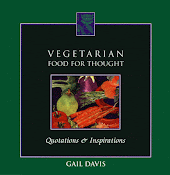
I think I've said this before elsewhere in this blog: When I was in India, it was astounding to me how difficult it was for a predominantly vegetarian country to wrap it's collective brain around the idea of veganism. More than once I bit into a piece of paneer in a dish that was ordered without cheese. And I'm sure that many a curry was served in a cream sauce or cooked with ghee, even though it was requested that no dairy be used in the preparation of my meals. But that's history, and I'm told that things are slowly changing in India, and people are beginning to learn that the dairy they consume does not generally come from happy, well-treated cows.
Author Madhu Gadia, a registered dietitian living in Ames, Iowa, admits how difficult it was for her to think and cook outside the lacto-vegetarian box, not realizing how extensively and automatically she added dairy products to the dishes she prepared and enjoyed. It is our good fortune that she took the time to research vegan nutrition and create this beautiful book with more than 150 delicious and authentically Indian vegan recipes.
Newcomers to Indian cuisine will appreciate her glossary of spices and other unfamiliar ingredients, list of basic kitchen equipment, tips on cooking techniques, and perhaps most helpful, a list of online retailers for those difficult-to-find ingredients. As a long-time Indian-food lover and aficionado of curries, I appreciated the new world of dishes this book made available to me, like Stuffed Mung Been Pancakes (Bharva Cheele) and Dried Fruit Rice (Meva Chawal). For me, finding a vegan recipe for Badam Barfi (a sensuously sweet almond pastry made with edible foil) was like finding hidden treasure! The challenge for me was going to be preparing these delicious dishes without the oil used in most recipes, while maintaining the integrity and the full flavor of each.
One of my favorite Indian dishes ever is Vegetable Korma, which is typically made with heavy cream. Needless to say, I haven't tasted a decent korma in decades. Madhu's recipe for Creamy Vegetable Stew (Subji Korma) used cashews to give the dish its characteristic creamy taste and texture. To maintain my McDougall diet program, I omitted the three tablespoons of canola oil called for in making this dish, and still the result was incredible. Otherwise following Madhu's directions, the onions, green beans, cauliflower, carrot, peas, and peppers cooked to perfection, delicately, without risk of being overcooked. It was delightfully fragrant served on a bed of basmati rice.

Next, I tried making a dish I had never eaten before, Pav-Bhaji, which literally translates to "vegetables on a bun," but Madhu refers to as "Veggie Sloppy Joe Sandwiches." Made with potatoes, onions, cauliflower, green peppers, peas, carrots, and tomatoes, the dish is seasoned with pav-bhaji masala (one of many different masala spice blends) and lemon or lime juice. It's absolutely fascinating to me how very different each dish tastes depending on the type of spices used. And once again, I omitted the oil called for in this dish, replacing it with water, and still it tasted delicious. I didn't have the heart to eat my pav-bhaji on an American whole wheat bun, so I opted to scoop mine up by the "spoonful" with torn pieces of whole wheat chapati.

I hadn't realized that "dal" is the generic name for all dried beans, peas, lentils, legumes, and pulses, and is used interchangeably for both dry and cooked beans. Madhu has included recipes for more than a dozen dals, and because I had some pink lentils on hand, I chose to try her Ginger-Spinach Pink Lentils or Andrak-Palak Dal. It required the use of asefoetida which has a very strong and pungent odor, but imparts a very distinct yet pleasing flavor to dishes. Asefoetida powder smells so awful, it's also known as "stinking gum" and "devil's dung," so it's important to store it in a tightly-sealed container, or it will stink up your whole kitchen. I choose a glass jar with a tight-fitting lid for this purpose. Of the three dishes I tried, I must say that I liked this dish the best of all. And that's pretty remarkable, because I never thought of myself as a huge fan of dal, when there are so many other tasty Indian dishes to be savored. But the combination of ginger, lentils, spinach, and tomatoes along with cumin seeds, coriander, cayenne, and yes, asafeotida, made this dish powerfully flavorful and satisfying. Again, I did without any of the cooking oil, and don't believe that I sacrificed any of the flavor. Served along with a plate of nutty-tasting brown basmati rice, I felt as though I was eating something sinfully rich, though it was deliciously hearty and vibrantly healthful.

I look forward to trying many of the delectable-sounding desserts and beverages in
The Indian Vegan Kitchen as well as the flat breads, salads, chutneys, and more of the curries. This is a lovely book filled with exotically inspired recipes that will bring a great deal of eating pleasure to both vegans and non vegans alike.
























